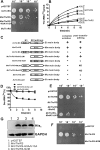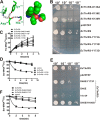Translational Quality Control by Bacterial Threonyl-tRNA Synthetases
- PMID: 27542414
- PMCID: PMC5076528
- DOI: 10.1074/jbc.M116.740472
Translational Quality Control by Bacterial Threonyl-tRNA Synthetases
Abstract
Translational fidelity mediated by aminoacyl-tRNA synthetases ensures the generation of the correct aminoacyl-tRNAs, which is critical for most species. Threonyl-tRNA synthetase (ThrRS) contains multiple domains, including an N2 editing domain. Of the ThrRS domains, N1 is the last to be assigned a function. Here, we found that ThrRSs from Mycoplasma species exhibit differences in their domain composition and editing active sites compared with the canonical ThrRSs. The Mycoplasma mobile ThrRS, the first example of a ThrRS naturally lacking the N1 domain, displays efficient post-transfer editing activity. In contrast, the Mycoplasma capricolum ThrRS, which harbors an N1 domain and a degenerate N2 domain, is editing-defective. Only editing-capable ThrRSs were able to support the growth of a yeast thrS deletion strain (ScΔthrS), thus suggesting that ScΔthrS is an excellent tool for studying the in vivo editing of introduced bacterial ThrRSs. On the basis of the presence or absence of an N1 domain, we further revealed the crucial importance of the only absolutely conserved residue within the N1 domain in regulating editing by mediating an N1-N2 domain interaction in Escherichia coli ThrRS. Our results reveal the translational quality control of various ThrRSs and the role of the N1 domain in translational fidelity.
Keywords: aminoacyl tRNA synthetase; protein synthesis; transfer RNA (tRNA); translation; translation control.
© 2016 by The American Society for Biochemistry and Molecular Biology, Inc.
Figures









References
-
- Ibba M., and Soll D. (2000) Aminoacyl-tRNA synthesis. Annu. Rev. Biochem. 69, 617–650 - PubMed
-
- Cusack S. (1997) Aminoacyl-tRNA synthetases. Curr. Opin. Struct. Biol. 7, 881–889 - PubMed
-
- Schimmel P. (1987) Aminoacyl tRNA synthetases: general scheme of structure-function relationships in the polypeptides and recognition of transfer RNAs. Annu. Rev. Biochem. 56, 125–158 - PubMed
-
- Ling J., Reynolds N., and Ibba M. (2009) Aminoacyl-tRNA synthesis and translational quality control. Annu. Rev. Microbiol. 63, 61–78 - PubMed
MeSH terms
Substances
Associated data
- Actions
LinkOut - more resources
Full Text Sources
Other Literature Sources

